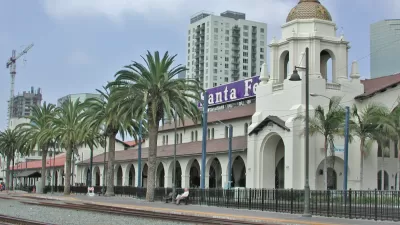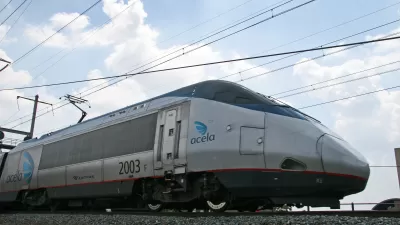Acela has improved connectivity along the Northeast Corridor, but is that actually a good thing? Aaron M. Renn argues that high-speed rail has actually hurt America by giving the finance industry a stranglehold over fiscal and monetary policies.
"I think it's very clear that transportation networks have vast impact on the structure of society, not just how people and goods get from Point A to Point B," says Renn. He acknowledges the success of Acela in closely linking Boston, New York, and Washington, but believes that the shrinking distance between Wall Street and K Street has been unhealthy for America. "During the financial crisis, the government and the Fed have kept Wall Street well supplied with bailouts and nearly free access to capital that allows them to literally print risk free profits by recycling in the free loans into interest bearing government debt," Renn explains, "all while Main St. businesses and homeowners have borne the full brunt of a credit crunch, state and local governments fiscally starve, and infrastructure funds dry up."
The geographic proximity of New York to Washington facilitates the imbalance of the finance industry while allowing insiders to obtain "a near lock on the position of Treasury Secretary" and letting figures responsible for financial meltdowns go free. "Indeed, advocates of high speed rail boast of the positive transformational effects of HSR as one of the reasons to build it. But was with the interstate highway system, we need to be aware of the hidden risks as well," cautions Renn. "The Acela is perhaps living proof that high speed rail can reshape America. It is literally helping rewrite the geographic power map of America. Unfortunately, at this point don't think that's been a good thing."
FULL STORY: Is The Acela Killing America?

Maui's Vacation Rental Debate Turns Ugly
Verbal attacks, misinformation campaigns and fistfights plague a high-stakes debate to convert thousands of vacation rentals into long-term housing.

Planetizen Federal Action Tracker
A weekly monitor of how Trump’s orders and actions are impacting planners and planning in America.

San Francisco Suspends Traffic Calming Amidst Record Deaths
Citing “a challenging fiscal landscape,” the city will cease the program on the heels of 42 traffic deaths, including 24 pedestrians.

Defunct Pittsburgh Power Plant to Become Residential Tower
A decommissioned steam heat plant will be redeveloped into almost 100 affordable housing units.

Trump Prompts Restructuring of Transportation Research Board in “Unprecedented Overreach”
The TRB has eliminated more than half of its committees including those focused on climate, equity, and cities.

Amtrak Rolls Out New Orleans to Alabama “Mardi Gras” Train
The new service will operate morning and evening departures between Mobile and New Orleans.
Urban Design for Planners 1: Software Tools
This six-course series explores essential urban design concepts using open source software and equips planners with the tools they need to participate fully in the urban design process.
Planning for Universal Design
Learn the tools for implementing Universal Design in planning regulations.
Heyer Gruel & Associates PA
JM Goldson LLC
Custer County Colorado
City of Camden Redevelopment Agency
City of Astoria
Transportation Research & Education Center (TREC) at Portland State University
Jefferson Parish Government
Camden Redevelopment Agency
City of Claremont




























